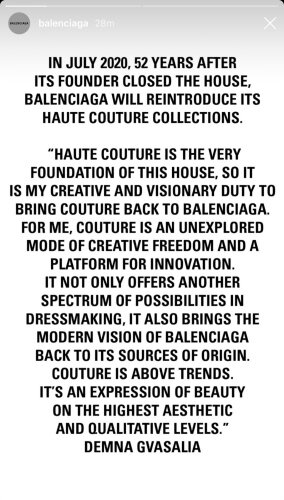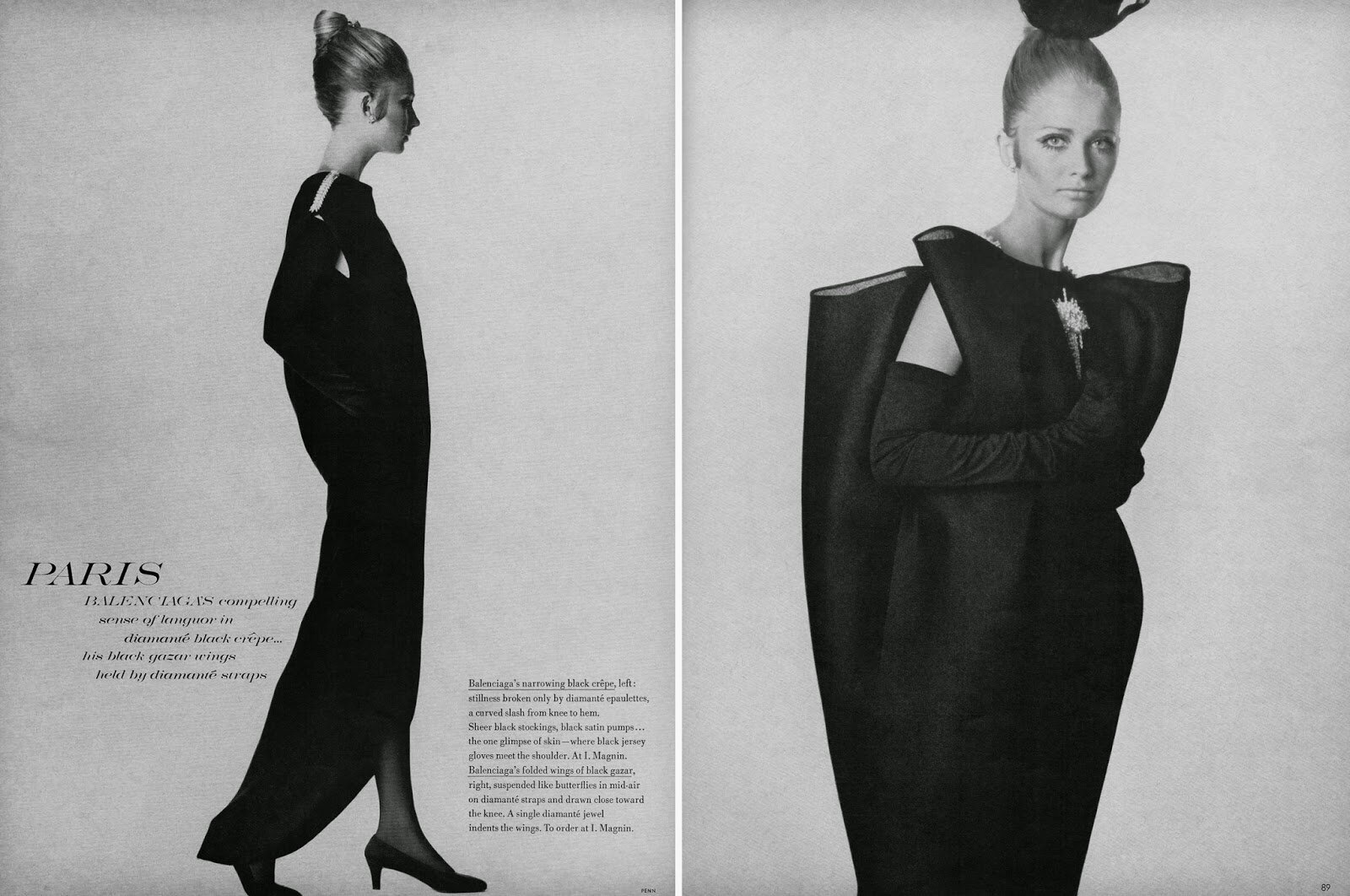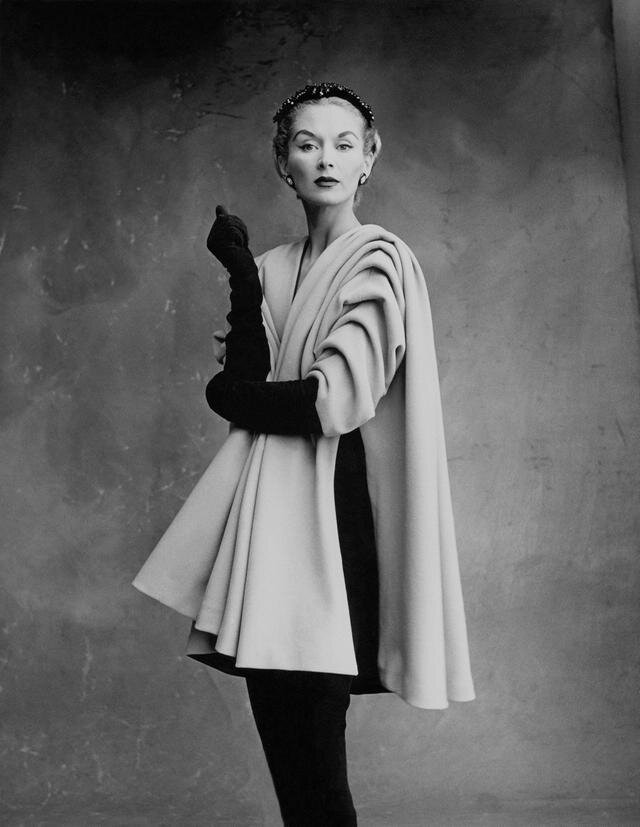The History of Haute Couture and its Future at Balenciaga
Source: @balenciaga
In 1968, the atelier at Balenciaga shut its doors for good until it reopened as a ready-to-wear line in 1987 by Michel Goma. Fifty-two years later, the current creative director, Demna Gvasalia, is breathing new life into the beautiful art of Haute Couture. The co-founder of Vetements, Gvasalia recently left his position at the company in the hands of his younger brother, Guram, to focus his creative energy on the Maison.
When thinking of Haute Couture, the term itself brings up a range of mixed reactions. Many view it as a dying or unnecessary anomaly of the fashion industry, especially in an influencer-driven era. Companies such as FashionNova, ASOS, and BooHoo are all examples of fast-fashion labels that factory-make and copy the runway trends, quickly and cheaply with lower quality materials.
What exactly is Haute Couture? In essence, it is the art of creating custom clothing tailored perfectly to the client’s body. According to the Business of Fashion’s Fashion A-Z education, “to qualify as an official Haute Couture house, members must design made-to-order clothes for private clients, with more than one fitting, using an atelier (workshop) that employs at least fifteen fulltime staff. They must also have twenty full-time technical workers in one of their workshops. Finally, Haute Couture maisons must present a collection of no less than 50 original designs — both day and evening garments — to the public every season, in January and July.” This is definitely not an easy feat, even for the most seasoned designers.
Source: MVC Magazine
However, the art of Haute Couture has layers of history that have majorly impacted the fashion designs, techniques, and silhouettes of today. The Dior Bar Jacket is an iconic staple that has been referenced by various designers over the years since its debut in 1947. The silhouette of a feminine cinched waist juxtaposed with a masculine suit jacket has become an instant classic ever since Harper’s Bazaar Editor-in-Chief Carmel Snow deemed it “The New Look.”
The Chambre Syndicale de la Haute Couture is the governing body that oversees Haute Couture globally. The federation’s school counts famous designers such as Valentino Garavani, Yves Saint Laurent, and Karl Lagerfeld among its vast network of alumni. Similar to the usage of the word champagne, the term “Haute Couture” cannot be used in any unofficial capacity. It only applies to the brands that have maintained the organization’s extremely high standards.
Source: FT Image Publish
In another effort to protect the art, L’Association de Protection des Industries Artistiques Saisonnières (PAIS) was created by the French press to prevent the copying of couture designs and continue the legacy of extravagant clothing. Photographs of the front and back of the mannequin are used as evidence.
Cristóbal Balenciaga was, first and foremost, a couturier designer. Hailing originally from the Basque country of Northern Spain, he pushed the boundaries of clothing with his precise tailoring. Balenciaga was a self-taught tailor who got his interest in fashion from his mother, who was a widowed seamstress. He moved to San Sebastian to open his couture house in 1937. Balenciaga often traveled to Paris to buy the latest designs from Chanel and Schiaparelli, taking apart the clothing and figuring out the techniques used by the masters. After the start of the Spanish Civil War, Balenciaga left Spain and relocated to Paris and reopened the Balenciaga atelier in 1937. Among his fans were Gabrielle Chanel, Christian Dior, and student Hubert de Givenchy, who kept his teacher’s work and donated it to museum archives before his own death.
Sources: The National & Bourg Tibourg
In Gvasalia’s recent collection for Spring 2020, looks 87 through 91 consisted of four dresses with massive-volumed skirts to close out the show. The DNA of Cristóbal Balenciaga’s couture tailoring shone through and was met with acclaim. Look 83 could also be seen as a nod to the Audrey Hepburn look for Vogue Italia in 1969.
While it may not seem like it, there are many stark similarities between Gvasalia and Balenciaga. Both are revolutionaries: Balenciaga rebelled against the traditional Chambre Syndicale de la Haute Couture system; Gvasalia chose to show his Vetements collection during the couture calendar, instead of the standard prêt-à-porter timings. Both have links with street-wear fashion: Gvasalia’s work at Vetements is strictly streetwear; Balenciaga had incredible daywear looks. Both of the designers are known for being mysterious recluses: Balenciaga gave one interview during his time in fashion; Gvasalia didn’t put his face to Vetements during its initial debut in 2014.
Source: Vogue
It is not hard to see why Gvasalia chose to reopen the atelier and follow in Cristóbal Balenciaga’s footsteps. There is much hope that Gvasalia will brilliantly take the historic codes from the Balenciaga atelier and come up with similarly beautifully crafted designs. Gvasalia’s first Haute Couture collection will debut in July 2020 at the historic Balenciaga Paris address 10 Avenue George V.






